How do you choose the best Canon camera? Read our expert reviews of the latest Canon DSLR digital cameras and compare the very best deals.
Compact cameras are a great choice for beginner photographers, and also for those who are looking for good quality, take-everywhere camera as a backup to their DSLR or bridge camera.
While most modern smartphones have a decent camera built-in, to take your photography to the next level, you’ll need a dedicated camera. And these days a compact, point, and shoot camera, with good specifications, doesn’t have to break the bank.
Below we’ve picked out the Best Canon cameras with details review .
Our Top Picks: Canon Camera Highlights
- Best Flagship Models Camera: Canon EOS 7D Mark II
- Best Enhanced Formidable Camera: Canon EOS 80D
- Best Stands Out From The Crowd Camera: Canon-EOS-100D
- Best Starting To Show Its Age Camera: Canon EOS 700D
- Best Mid Range DSLR Camera: Canon EOS 750D
- Best Premium Entry Level DSLR Camera: Canon EOS 760D
- Best Crowded Sector Strong Camera: Canon EOS 800D
- Best Competent Entry Level DSLR Camera: Canon EOS 1300D
- Best Incredible Zoom To effortlessly Camera: Canon Powershot SX620
- Best Optical Shoot Digital Camera: Canon IXUS 185
- Best Entry Level Cameras: Canon EOS 77D
- Best Flagship Full Frame DSLR Camera: Canon EOS-1D X Mark II
- Best Update Flagship Models Camera: Canon EOS 7D Mark II
- Best Affordable Full Frame DSLR: Canon EOS 6D
- Best Perfect Shooter Beginners Camera: Canon EOS 1200D
Top 15 Best Canon Camera Reviews
Best Flagship Models Camera
-
Canon EOS 7D Mark II
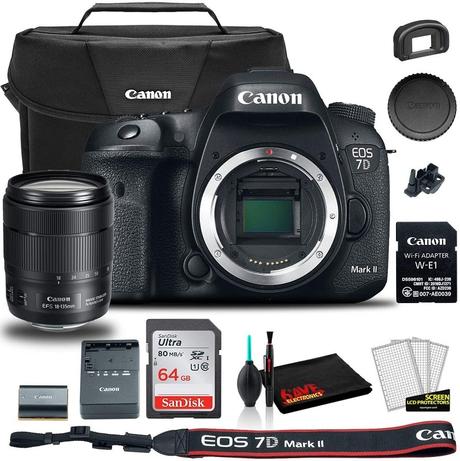
Check Price
The EOS 7D Mark II is a serious piece of hardware. It integrates Canon’s latest dual-pixel CMOS auto-focusing technology with a 65 point all cross-type AF system that is borrowed from the flagship EOS 1DX Mark II and then improved.
The Canon EOS 7D Mark II builds on the reputation, performance and ergonomics that was set by its predecessor the EOS 7D.
Canon has always made it possible for APS-C photographers to really get the feeling of what it is like to wield a pro-level DSLR, without actually having to pay an insane amount of money.
In other words, Canon has always been serious about making available better and faster more performance oriented APS-C bodies with features that are frequently borrowed from their flagship bodies and sometimes improved.
Nikon has been far more circumspect in doing the same.
The result is amazing cameras such as the EOS 7D. The 7D, however, had become a dated design.
There was need for a better more powerful camera than the 7D. Thus, entered the much anticipated 7D Mark II. In many ways the 7D Mark II embodies the best of two worlds – a smaller form factor and with that combined the features of a pro body.
Even at the risk of sounding like an oxymoron, the EOS 7D Mark II is a camera that is aimed at not only APS-C enthusiasts but also serious pro level shooters who would love to take advantage of the crop factor with their long lenses.
Specifications
The Canon EOS 7D Mark II ups the resolution benchmark – 20.2 megapixel against 18 megapixel, but loses out on the individual size of the photodiodes 4.1 µm against 4.3 µm.
This is a vital piece of specification that often evades even the most seasoned eye. The smaller the individual size of the pixels, the less their ability to capture light. Smaller photodiodes also lead to noisier images.
Image Processing
The EOS 7D Mark II gets a dual DIGIC 6 image processor when compared to the EOS 7D.
The extra speed is noticeable as the 7D Mark II shoots full resolution stills at 10 fps and full HD videos at 60 fps, 30 fps and 24 fps with continuous auto-focusing. More on the continuous auto-focusing later in this review.
Auto-focusing: On-chip Phase Detection
The most notable feature of the EOS 7D Mark II is its dual-pixel CMOS auto-focusing system.
This is not the first time that we have seen this though. There are other cameras in the Canon line-up that already have this feature – the EOS 80D and before that the EOS 70D to name two.
This technique uses a revolutionary new sensor design.
80% of the pixels on the sensor are actually a composite of two individual photo-diodes. Each set sees an image coming in from one side of the lens only. These ‘twin’ images are then compared with each other and aligned to bring the final image into focus.
The technique is reminiscent of how rangefinder cameras work. In this case, however, the technology is marketed as on-chip phase detection system. This technology makes the older, slower contrast detection auto-focusing system redundant.
Advantages of the On-chip phase Detection System
The advantage of this system is that it is faster than traditional contrast detection systems that work only when the mirror flips away from in front of the sensor. Plus, being essentially chip based, the system is always on.
Another big advantage is that the system works in tandem with Canon’s STM lenses.
The greatest advantage is for those who shoot mostly in live-view or shoot videos. Continuous auto-focusing in video mode was a touchy subject in DSLR AF designing. Not many systems had accurate and reliable continuous auto-focusing in video mode before Canon came out with the dual-pixel CMOS AF system.
This camera boasts something which even the flagship EOS 1DX Mark II doesn’t have: a 65-point all cross-type AF system. The 61-point high-density reticular AF system that is on the EOS 1DX Mark II has only 41 cross-type AF points.
The center point of this high density cluster is a highly sensitive dual cross-type AF point that works with lenses f/2.8 or faster and can auto-focus even in -3EV.
This is ideal when shooting in extreme low light condition such as when shooting at indoor events or shooting wildlife at or after sundown.
Compatibility with STM lenses
STM stands for stepping motor. This is a smoother, much quieter AF motor and is an improvement over the older USM or ultra-sonic motors. This system produces a bit slower AF performance but the result, particularly when shooting videos is a lot smoother.
With USM lenses you would have suffered faster but jerkier AF which is an issue in film / video making. With STM lenses you don’t suffer the same problem.
Still Shooting
As already mentioned, continuous shooting speed is 10 fps at full resolution. Not many cameras except Sony’s DSLT (Digital Single Lens Translucent) cameras can shoot at 10 fps or higher.
Of course we are leaving out full-frame pro-level DSLRs in this discussion.
The EOS 7D Mark II is definitely ideal for shooting fast action, sports and wildlife photos, especially when birding. The crop factor of the APS-C sensor automatically makes the focal length of all full-frame lenses multiplied by a factor of 1.6x.
Even if you have a full-frame camera it would be fun to shoot with this camera for the ‘extended’ focal length.
Image sizes are 5472 x 3648 pixels. That means you can make large 18” x 12” industry standard 300 DPI prints without any loss in resolution. That too without having to upscale the image.
The camera supports 14-bit RAW.
ISO range
All cameras have what is known as a native and an extended ISO range.
The native ISO range is what the camera is able to shoot at without any software interference. Once that is transgressed the camera uses software to further increase the sensitivity of the sensor.
The native ISO range of the EOS 7D Mark II is 100-16000. On extended mode the ISO range extends to 51200.
You are definitely going to have a lot of noise when shooting at those ISO numbers.
Viewfinder & LCD Screen
The large and bright pentaprism powered viewfinder gives 100% frame coverage. This is imperative for making accurate compositions, especially for photographers who love to get it absolutely right in the camera.
The back of the camera is dominated by a large 3” LCD screen with a resolution of 1,040k-dots. This is a non-articulating screen.
This is basically where cameras like the EOS 80D win, because, with the 7D Mark II you are kind of limited with the camera angles you can shoot from. By the way, the screen gives 100% frame coverage.
Video Shooting
The video modes on the EOS 7D Mark II are more than enough for an enthusiastic videographer. The dual DIGIC 6 image processor ensures that the camera can handle high frame rates with élan.
It shoots full HD at 60, 30 and 24 fps. You have the option to shoot in either MOV or web-friendly MPEG-4 compression.
Plug, in an optional HDMI cable and you can capture the RAW unprocessed footage straight on an external recorder for further processing. Clips are fragmented after they reach a maximum file size of 4 GB.
The thing that you would be missing though, is built-in stereo sound recording. The EOS 7D Mark II only records linear PCM sound. You can however, plug in an external mic to record stereo quality sound. There’s also a headphone jack input that allows you to monitor the real time recording of sound.
Other Features<
There are a bunch of other features on the EOS 7D Mark II. These include:
- Dual card slots for both CF and SD cards
- Built-in GPS
- Built-in intervalometer
- Compatibility with Canon’s eTTL flash system
- Built-in flash
- 150,000 pixel RGB metering + IR metering sensor.
- Magnesium alloy construction
- Significantly better weather sealing than the older 7D
- Hot-shoe to mount an external flash or other accessories
- USB 3.0 connectivity
- Better shutter cycle rating compared to its peers (200,000 against 150,000 on the Nikon D7200 and the older EOS 7D)
Conclusion
Overall, the EOS 7D Mark II is a serious piece of hardware. It integrates Canon’s latest dual-pixel CMOS auto-focusing technology with a 65 point all cross-type AF system that is borrowed from the flagship EOS 1DX Mark II and then improved.
It shoots stills at a phenomenal 10 fps, making it a dream for action, sports and wildlife photographers looking to use a long lens and take advantage of the crop factor.
Plus, the camera structure is a robust magnesium alloy construction and comes with, as Canon puts it, ‘4 times better weather sealing than the original 7D’ – something that outdoor photographer will feel a lot better when heading outdoors.
To conclude, the EOS 7D Mark II is a far superior camera than the one it replaces. It is definitely a great buy considering all aspects.
Read Customer Reviews on Amazon!
Best Enhanced Formidable Camera
-
Canon EOS 80D
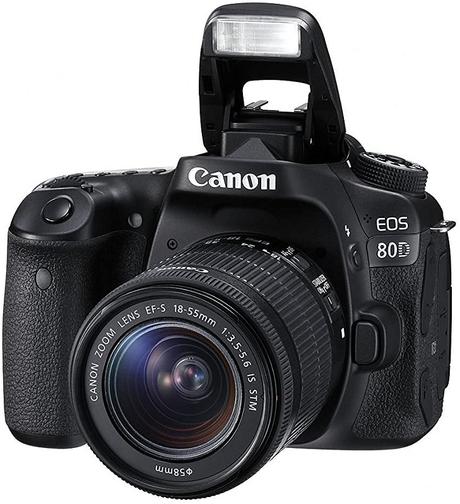
Check Price
The Canon EOS 80D is a prosumer segment DSLR camera based around an APS-C sensor. It has a resolution of 24.2 megapixels and is powered by Canon’s DIGIC 6 image processing engine. The EOS 80D is the successor to the EOS 70D, the previous undisputed video champion among Canon’s APS-C sensor based DSLRs. It featured the revolutionary new dual-pixel CMOS auto-focusing system. With the 80D, that technology is now merged with an improved set of functionalities. Let’s take a deeper look into its features and find out more about it.
Specifications
Some of the main features of the camera have already been sketched above. Apart from the new 24.2 megapixel sensor and the DIGIC 6 image processing engine, the camera also has a 45-point (all cross-type) hybrid auto-focusing system. It shoots full HD at up to 60 fps and has a decent 7 fps continuous shooting speed. The 80D loses out against the 7D Mark II, which is the current APS-C flagship camera in the Canon stable, in terms of shooting speed and AF performance.
Additionally, the 80D has a 7560 pixel RGB+IR metering system that is significantly better than the previous system. This system is a better one than the older 63-zone dual layer metering system in older Rebel series cameras and in the predecessor, the EOS 70D. Apart from the improved metering for landscapes and such other complicated metering requirements, the system is also extremely suitable for the purpose of subject tracking such as when shooting portraits of children and so on.
Image Processing
Canon’s DIGIC 6 image processing engine handles image processing on the EOS 80D. The DIGIC 6 also handles image processing on the much vaunted 7D Mark II as well as the EOS 5DS R.
Auto-focusing
The 80D’s auto-focusing is a much improved one compared to that of the 70D that it replaced. The 80D gets a 45-point all cross-type hybrid auto-focusing system. The number of AF points has a major bearing on the tracking efficiency, when shooting fast action as well as when recording videos. The 45 point all cross-type AF system on the EOS 80D is a much better solution when it comes to tracking a subject, compared to the 19 point system on the older camera. This, however, is no match for the 65-point system on the beefier 7D Mark II.
The 80D has the dual-pixel CMOS auto-focusing technology that we have now seen in a number of Canon systems. This revolutionary technology ensures that a camera is able to lock focus when shooting videos as well as when shooting in live-view (stills) much master than traditional cameras driven by contrast detect AF systems.
Still Shooting
Still performance with the 80D is an improved experience over that of its predecessor. The larger number of AF points definitely helps. What also helps is the better metering system. Subject tracking has improved as well. Though the whole system is not at par with the 7D Mark II’s intelligent tracking and recognition, it is not bad. Low light shooting has improved too. Being the highest resolution APS-C sensor (with smaller effective pixel size) it might seem that the camera would produce more noise. However, it is not the case with the EOS 80D.
ISO range
ISO range on the 80D is 100 – 16000
Viewfinder & LCD Screen
The pentaprism powered viewfinder of the EOS 80D is bright and gives 100% coverage of the scene captured through the lens. For live-view shooting or when shooting videos the 3” LCD screen is just perfect. The LCD screen also gives 100% frame coverage and the screen has a 170 ˚ viewing angle ensuring you can shoot from really acute angles without any issues monitoring what you are shooting.
Build quality
This is no 1DX and there is bound to be some cost cutting when developing an APS-C DSLR. Still then build quality is pretty ok. Exterior elements of the camera are designed in poly-carbonate hiding the magnesium alloy chassis underneath it. Weather sealing has been provided. However, don’t go overboard with it as this is not a completely weather sealed camera.
There are some nice new touches in the 80D including one that has been borrowed from the 5Ds inspired motor driven mirror technology. In normal spring driven mirror mechanisms a lot of shake is induced when the mirror flips away and locks. This is a prime candidate for image blur. With motor-driven mirror, the speed is controlled. There is no ‘slamming’ when the mirror flips away. Resultantly there is no exaggerated shake.
Video Shooting
The biggest drawback of the EOS 80D is its incapability to shoot native 4K videos. The photography world is moving steadily towards a 4K standard. Having said that the full HD video recording of the 80D is crisp. It offers two compression options. You can choose to record in MP4 version, in which case the recorded video is optimized with standard IPB compression. Alternatively, if you need slightly higher quality opt for the MOV version with All-I compression.
Video recording is where the dual-pixel CMOS AF systems really kicks in. Add to that the touch to focus feature of the 3” sensitive touchscreen. All you need to lock focus during movie or still shooting is to tap with your finger and voila! You have focus.
Connectivity
The EOS 80D comes with built-in Wi-Fi and NFC connectivity.
Conclusion
If you already own a full-frame camera and an array of lenses designed for the larger sensor, the 80D gives you a focal length multiplier of 1.6x, for all your lenses. That too without the associated disadvantage of a drop in maximum aperture. That means, buying the EOS 80D makes most of your long lenses now suitable for birding, wildlife and those sort of requirements.
Add to that the fast continuous shooting speed of 7 fps, improved metering and low light capabilities. The 80D is a formidable camera, make no mistake about it. It is a good camera to shoot stills with and to shoot videos with. Having said that, it is not the best that the crop sensor segment can offer. The 7D Mark II in the Canon line-up is a much better product with distinctly faster shooting speed, better metering technology and better ergonomics. It is definitely a better choice if you have a higher budget.
Read Customer Reviews on Amazon!
Best Stands Out From The Crowd Camera
-
Canon EOS 100D
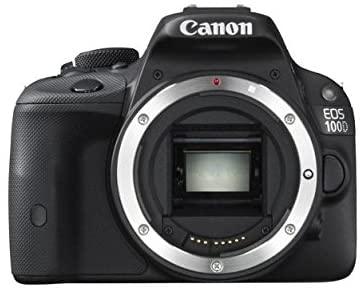
Check Price
There are many great cameras in Canon’s EOS range, but the EOS 100D is a model that definitely stands out from the crowd. This model is a good response to the popular CSCs (Compact System Cameras) on the market.
In the range of DSLRs, its place is between the Canon EOS 1100D and EOS 700D.
It is very suitable for use due to its small size and very low weight. Actually, this is one of the lightest and the smallest DSLRs in the world, which fits well even in large hands. However, this decrease in size and weight didn’t affect the quality of photos.
Photo & Video Quality
Although its 18MP APS-C sensor is thinner and smaller than typical DSLRs, it has the same resolution as other Canon EOS models and the quality of images is not reduced.
It features аn advanced phase-detect autofocus technology, a range of frame rates (24, 25, and 30fps), built-in 3.5mm mic port, as well as ISO range of 100-12,800 which can be extended up to 25,600.
Moreover, the sensor supports continuous AF during shooting. All of this results in high-quality HD videos and photos.
The 100D comes with a built-in flash, which allows a guide number of 9.4m. On the other hand, it cannot control the Speedlite flashguns wirelessly, so this is a big disappointment for those who use flash creatively.
As for the videos, there is full manual exposure control that enables the silent exposure adjustments on the touchscreen, however, the priority modes are not available for video.
Controls
The touchscreen interface is very similar to 650D, regarding the design and options.
Aside from the controls on the 3-inch touchscreen, there are also the physical dials and buttons for the additional controls.
How can you see the available controls? Just press the Q button and all controls will appear on the screen. Then, select one of them and adjust it using the command dial.
If you have used other Canon digital cameras, you will notice that the labeled functions are removed from the 4-way navigation pad.
You’ll mostly use the touchscreen when you want to zoom photos, set the autofocus point in the more exciting live view mode, and to give the star ratings during playback. Unfortunately, the screen is not articulated.
Also, this camera is not fast like the best CSCs, since it takes half a second to focus and deliver a photo.
Specifications/Features
- 18MP APS-C CMOS sensor
- 1920 x 1080 HD video capture
- ISO 100-6400, expandable to 25600
- DIGIC 5 Image Processor
- 1040k-dot, 3-inch LCD screen
- SPC TTL 63-zone metering system
- 3.0x optical zoom
- 9-Point AF System
- SDXC memory slot
- 94 x 117 x 150mm
- Weighs 612g
Design
The diminutive design looks very attractive, and all components are well composed in the small, compact frame.
There is a new 18-55mm lens with STM suffix which indicates the improved performances regarding the live view mode, as well as quieter and smoother focusing during recording.
While the lens is significantly improved compared to the previous kit lens, its length is increased by 5mm.
Battery Performance
Accordingly the overall small dimensions of the camera, the Li-ion battery is also small in size. Its capacity enables 380 shots, which is not ideal but quite enough for most users.
Pros
- Small and lightweight body
- HD 18.0 megapixels with speed of up to 4fps
- Nice design
Cons
- AF system features just one cross-type point
- Small battery means reduced capacity (380 shots)
- Price is similar to the EOS 700D
Read Customer Reviews on Amazon!
Best Starting To Show Its Age Camera
-
Canon EOS 700D
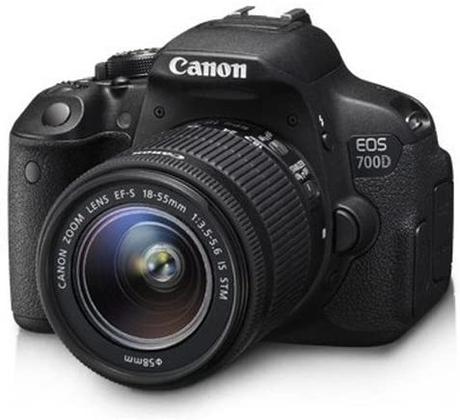
Check Price
The Canon EOS 700D is an upper entry level DSLR from Canon. Canon’s lower segment, cameras featuring the EOS 700D (also known as Rebel T5i) and the basic SL1 apart from the previous Rebel series cameras that Canon still continue to sell, is a much cluttered one. Multiple cameras that have overlapping features and none seem to be having everything that you need. Buy hey, this is an entry level segment and you have to make the decision as to which are the features that you must absolutely have in your camera. Let’s find out more about the 700D.
Sensor
The sensor inside the EOS 700D is the same old sensor that sat inside the EOS 650D. It is an APS-C sensor with an effective resolution of 18 megapixel and capable of churning out large fine RAW and JPEG frames of the size 5184 x 3456 pixels.
An interesting feature on the EOS 700D is multi-shot noise reduction. This technology enables the camera to make low-noise high contrast images even in low light conditions without any issues.
Image processing
Image processing is handled by Canon’s DIGIC 5 image processor.
Auto-focusing
The 700D’s auto-focusing technology is powered by 9 AF points only. But on the flip side all the AF points are cross-type. Cross type AF points are way more sensitive than line sensors.
ISO Sensitivity
The native ISO sensitivity of the sensor ranges from 100 to 12800. You can, however, expand the ISO capacity all the way to 25600.
Still Shooting
In continuous shooting mode the EOS 700D can shoot at 5 frames per second. Though, 5 fps is decent it is nowhere near what you need for shooting fast action or sports photography. Everyday photography, however, should be no problem at all.
Video Shooting
The EOS 700D is a capable video shooter. Auto-focusing is decent, though Canon has launched better live-view auto-focusing in later models. The 700D is capable of shooting at full HD at 1080p and at a maximum of 30 fps. Continuous auto-focusing in live-view is facilitated by Movie-Servo AF. At a slightly lower resolution of 720p you can shoot at a higher frame rate of 60 fps. Manual exposure adjustment is possible in move mode. Stereo mic records good quality sound.
Connectivity
There is no built-in wireless connectivity on this slightly dated model. Standard USB 2.0, HDMI C (Mini) and AV Output connectors are available.
Rear LCD Screen
The slightly dated EOS 700D has a 3” rear LCD screen that features ClearView II technology. The screen is vari-angle and comes with touchscreen abilities. Vari-angle functionality allows you to shoot from those impossible angles like an extremely top angle or an extremely low angle.
Another extremely useful feature of the LCD screen is the Touch Auto-focus. Together, these two features open up a world of options so far as shooting stills and videos are concerned.
Build Quality and Weather Sealing
Canon’s entry level or budget DSLRs are designed for consumers who are looking for something better than their smartphones. These cameras are in no way comparable to the mid-range or pro-grade cameras. Build quality, thus, is reminiscent of the budget. Still, the EOS 700D is a decently build camera. The vari-angle touchscreen comes with a smudge-resistant coating that ensures it does not end up being a dust and smudge magnet.
Read Customer Reviews on Amazon!
Best Mid Range DSLR Camera
-
Canon EOS 750D
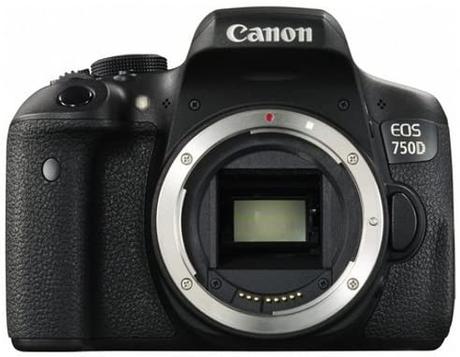
Check Price
The Canon EOS 750D is a DSLR that offers simple operation and great image quality. This model is also known under the name EOS Rebel T6i in the North America.
It is ideal for those who are looking for a reasonably affordable, reliable and functional camera to take pictures of their kids, friends, pet as well as vacation snapshots.
Also, those who are keen to learn the advanced principles of digital photography should consider this a great Canon camera.
As for the photo quality, the EOS 750D doesn’t compare with competitors, but it’s still one of the best-selling models on the market.
It is slightly faster than the previous Canon models regarding the back-display shooting and viewfinder and has built in Wi-Fi connectivity.
This makes it better than its predecessors and more attractive for consumers.
Performance
There are many improved performances, such as 19 autofocus areas at first place, which was only 9 at its predecessor. On the other hand, it takes a long time to focus and shoot – even 0.9 second.
However, other functions are very fast.
For instance, it is pretty slow while focusing in dark light conditions, but fast in both dim and bright light – takes only 0.3 seconds to focus and take a photo.
The same time is required for the raw and two sequential JPEG shots. If you turn on the flash, it will take about 1.2 seconds for two sequential shots.
This camera can make 30 JPEG photos at 5 frames per one second, which is quite good for the kids-and-pets photographers.
As for the raw continuous shooting, this model is a bit disappointing because it is satisfyingly quick when shooting 6 shots (at 6fps), and then suddenly falls to 2.4fps.
The good thing is that you can continue taking photos, more than 30, at that slower speed.
Live View is higher quality compared to the previous Rebels, however, it is still slow for the professionals.
Main features
- 24.2MP APS-C CMOS sensor
- Focus system: Hybrid CMOS AF III for live view
- An improved 19-point autofocus system
- 5 fps continuous shooting
- 3-inch fully articulating LCD touchscreen
- 7560 pixel RGB along with IR metring sensor
- 1080/30p video
- 100-12800 ISO range
- 3x optical zoom
- Wi-Fi with NFC
Image quality
As mentioned above, Canon EOS 750D is not in the class of the best digital cameras when it comes to the quality of photos. Also, there are fewer details in shadows and highlights.
On the other hand, the T6i’s image and video quality are fairly good in bright light.
Although it makes a noise while shooting, this is not the main issue of this camera. The main problem is a poor tonal range which results in losing details in blacks, but this can be compensated for in edit.
Actually, the Auto Picture Style makes too much contrast in low-light and causes bad JPEGs sharpness.
There is also the same problem in videos due to the limited tonal range.
It is quite easy to record HD movies with this camera. Then, you can transfer your videos and photos to a smart device (either iOS or Android) or share them online by using NFC and Wi-Fi.
Design
With a chunky black body, it has a typical Canon DSLR look.
Compared to the previous Canon cameras, the design mostly stayed the same with just a few new details, so most people will only recognise this model according to the name on at the badge of the camera.
The stereo mic is placed on either side, there are several new buttons on top, while the LED lamp for Wi-Fi status is on the left shoulder.
On the right shoulder of this model, there is the mode dial.
The outer parts are mainly made from the polycarbonate, which gives the plasticky feel.
Read Customer Reviews on Amazon!
Best Premium Entry Level DSLR Camera
-
Canon EOS 760D
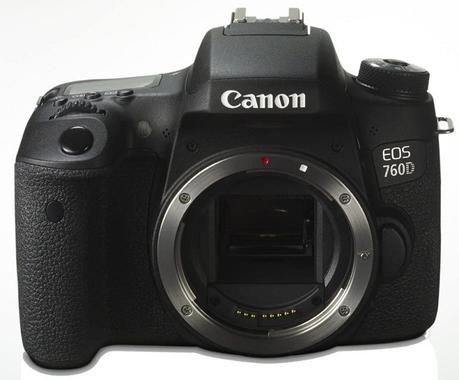
Check Price
The entry level DSLR camera segment has become somewhat of a clutter with competing companies offering a number of interesting products. The segment has been divided into a number of sub-segments. There is the entry level camera, followed by the upper entry and even a premium entry level. The EOS 760D falls under the last segment. Let’s find out more about the camera.
Sensor
The EOS 760D is powered by a 24.2 megapixel APS-C CMOS sensor. The high resolution sensor is capable of producing images the size of 6000 x 4000 pixels. Large enough for A4 size prints quite easily.
Image Processing
Image processing on the EOS 760D is handled by Canon’s DIGIC 6 image processing engine. DIGIC 6 is an extremely fast image processor.
Auto-focusing
Autofocusing mechanism of the camera is a 19-point all cross-type system. Cross type sensors are more powerful than line sensors because they are able to detect contrast in two dimensions compared to one which line sensors are capable of.
Additionally the hybrid CMOS AF III mechanism works like a charm in video shooting as well. When you switch on the live-view you no longer get assistance from phase detection sensors inside the camera. But unlike the slower contrast detect AF sensors in traditional auto-focusing Canon’s hybrid system provides faster auto-focusing in live-view. It does this using sensor based phase detection sensors which turn on during live view shooting.
Add to that a 7560-Pixel RGB + IR metering sensor for accurate scene recognition and better white balance setting than traditional sensors.
ISO Sensitivity
The native ISO sensitivity of the camera is 100 – 12800. In the extended mode it can shoot between ISO 100 – 25600.
Still Shooting
Continuous shooting speed of the camera is only 5 fps. 5 fps may not sound much and it is certainly not suitable for capturing fast action or sports and certainly not for shooting fast moving birds. Having said that you can certainly make travel photos, your kids playing on the beach etc.
Video Shooting
These days it isn’t enough just to be able to shoot still photos. Specially the entry level and the semi-professional DSLR segment. The EOS 760D, thus, shoots videos as well. It can shoot full HD videos (1920 x 1080) at a frame rate of 30 fps. Built-in microphone records stereo quality sound.
Rear LCD Screen
The 3” rear LCD screen has a resolution of 1.04m-dots. The LCD screen can pivot and that is a great feature to have when shooting videos or shooting stills in live-view. The rear LCD screen incorporates ClearView II touchscreen technology.
Connectivity
The EOS 760D comes equipped with both built-in wireless and NFC connectivity. Built-in wireless is ideal for transferring images and videos. NFC ensure faster pairing with compatible devices.
Build Quality and Weather Sealing
Canon’s entry and upper entry level cameras are not deigned to withstand the vagaries of nature. They can take a bit of bump and knock, but in case you are planning to work in inclement weather this is not the camera that you should carry with you.
The camera however feels premium in the hands though. It gets a top LCD screen, something that is reserved for upper category cameras only. This is a first for in Rebel series cameras.
Read Customer Reviews on Amazon!
Best Crowded Sector Strong Camera
-
Canon EOS 800D
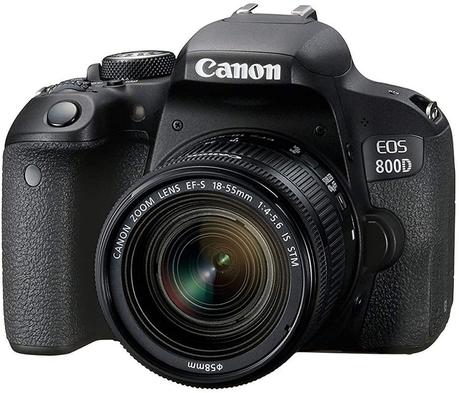
Check Price
Breaking a tradition of sorts the EOS 800D (Rebel T7i in the US) and the EOS 77D were launched at the same time. Both of these are very capable APS-C sensor DSLR cameras. The APS-C system segment has become a lot cluttered these days and with the launch of these two cameras the choice has become both sizeable and confusing at the same time. There are a number of cameras that have overlapping features but none seem to be having quite everything. So, that brings us to the million dollar question – Should you go for the new EOS 800D? Let’s find out more about the camera to decide.
- Canon EOS 800D Vs Nikon D5600
Sensor
The EOS 800D comes with a 24.2 megapixel APS-C CMOS sensor. The high resolution sensor is capable of producing large fine JPEGs and RAW frames of the size 6000 x 4000 pixels. Higher megapixels are preferred by landscape, food and commercial photographers because they can capture a lot of resolution, ideal for printing big.
Image Processing
The EOS 800D has been equipped with Canon’s latest DIGIC 7 image processing engine (the same as the EOS 77D). DIGIC 7 image processing should be able to produce fantastic results in low light as well perform better when shooting in continuous mode.
Auto-focusing
The EOS 800D gets a 45-point all cross-type auto-focusing system. Cross-type AF systems are faster, more sensitive and definitely more reliable when it comes to low light and low contrast situations. In bright light they are super quick.
Along with the 45 AF points, the camera has an intelligent metering system in the form of a 7560-pixel RGB+IR metering sensor. This sensor can accurately meter complicated scenes. It has been optimized to better track skin tones for accurate metering when making portraits and stuff.
ISO Sensitivity
DIGIC 7 image processor gives the EOS 800D a slightly better ISO performance. Native ISO range of the camera is 100 to 25600. In the extended range the sensor can also shoot at 100 – 51200.
Still Shooting
Continuous shooting speed of the EOS 800D is a respectable 6 fps. Though you would not be happy shooting sports or action, you would get more than satisfactory result shooting family and wedding.
Video Shooting
The EOS 800D is capable of recording full HD videos (1920 x 1080p). At a fame rate of 59.94 fps. Built-in stereo microphone on the camera records good quality sound. There is an option to plugin an external stereo mic. You can buy an external better quality noise canceling mic to record even better pro-quality sound.
Rear LCD Screen
A 3” LCD touchscreen gives bright display at a resolution of 1040,000. One wouldn’t recommend judging the quality of the images when displayed on the rear LCD screen. But a good display is necessary for a quick review. The screen coverage, however, is a disappointing 95% only. This is the bane with entry level DSLRs. if you are shooting in live-view mode you should keep in mind the areas immediately around the frame to ensure you don’t capture anything untoward.
Connectivity
The EOS 800D has built-in Wi-Fi, NFC and Bluetooth connectivity. Bluetooth connectivity ensures that you can pair the camera with a compatible device and use that as a remote trigger. NFC is a pure magic when it comes to pairing the camera with a compatible device. Built-in wireless is a big advantage when you have to transfer images and videos from your camera to your laptop.
Build Quality and Weather Sealing
The EOS 800D isn’t an all-weather camera. There are better cameras out there which has these features.
Read Customer Reviews on Amazon!
Best Competent Entry Level DSLR Camera
-
Canon EOS 1300D
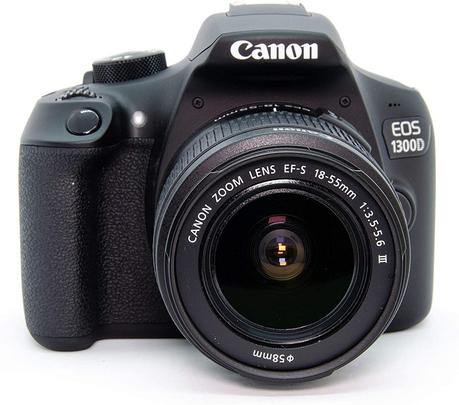
Check Price
This Canon camera is actually an update to the previous EOS 1200D model, which has a few improvements such as built-in NFC and Wi-Fi, as well as the brand new scene effects and modes.
We can say for this model that it’s more evolution than revolution, since there are not many new functions compared to its predecessors.
The updates over EOS 1200D are:
- Built-in Wi-Fi and NFC
- DIGIC 4+ processor
- 3-inch 920K dot screen
- Food scene mode
- Grainy black & white effect
What makes this camera so appealing to the customers is its affordable price. For the body-only, you should pay £299.99, while the bundle with 18-55mm III kit lens costs £344.99 or £384.99 with the advanced 18-55mm IS II lens.
What is the Canon EOS 1300D?
The Canon EOS 1300D (also known as the EOS Rebel T6 in North America) is a great DSLR with an 18-megapixel APS-C sensor that is perfect for the professional photographer. This small budget-friendly digital camera has a powerful DIGIC 4+ image processor as well as a broad ISO range of 100-6400 which can be extended up to 12800 when taking pictures in bright or low light.
And that’s not all! It also features 3p fps burst shooting and an advanced 9-point AF system that comes along with a built-in cross-type sensor.
You can connect it to the Android and iOS devices by using the special Canon Connect application.
Main Specifications
Here are the main specs of the Canon EOS 1300D:
- 18.0 Megapixel CMOS image sensor
- DIGIC 4+ Image Processor
- ISO 100-6400 which is expandable to 12800
- Built-in Wi-Fi and NFC
- 9 point AF system
- Continuous Shooting Speed at 3 fps
- Maximum Shutter Speed 30 seconds
- 3in LCD monitor
- 3x optical zoom
Image quality
As you might assume, this camera takes excellent photos and HD videos as well. Thanks to the 18.0 MP APS-C CMOS sensor, Digic4+ processor and other great features, the photos have great quality.
The sensor is capable of shooting three shots per second, which is quite enough for beginners. As for the ISO, its sensitivity goes up to 6400 and it is expandable up to 12800.
As already mentioned, it records Full HD videos and features 9 AF points.
Design
The first thing you’ll notice at this camera is a fairly light and smooth body, as this model doesn’t have a big processor and sensor.
It has a very comfortable grip and fits well in hand due to the small dimensions and textured surface.
The size is 5.4 x 8.7 x 6.5 inches and it only weighs 3.2 pounds.
Compared to the 1200D, it is more compact and slimmer. The body is produced from carbon fibre polycarbonate. Unfortunately, it’s not weather-sealed.
Easy manoeuvrability makes this camera convenient for beginners. All functions are easily accessible while the control buttons are well positioned.
In addition, there are also White Balance control buttons, Q button, video control button (next to the viewfinder on the back panel), and a dedicated ISO.
The 3 inches LCD screen is much improved and has 920K dots as well as a higher resolution than EOS 1200D.
Battery
The camera requires a Lithium-ion battery to work. The battery enables 500 shots, which is a considerable number and that is enough to fill up an 8 GB SD card.
All in all, this is quite good when it comes to the Canon Digital SLR, however not in the first class like the Sony Alpha A58 and Nikon D3300 for example, which offer up to 700 shots on a single charge.
Read Customer Reviews on Amazon!
Best Incredible Zoom To effortlessly Camera
-
Canon Powershot SX620
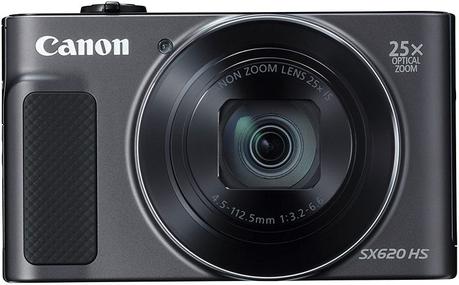
Check Price
While the DSCWX350 is our favorite camera at this price point, the Powershot SX620 certainly runs it close.
Specs wise its actually a little better – with a 20.2MP lens and 25X optical zoom. And like the DSCWX350, it also has built in Wi-Fi and NFC. Oh, and it captures video in full HD 1080p.
So why do we prefer the Sony?
Well, in most conditions the performance of the 2 cameras is pretty similar, but we found the Sony outperformed the Canon in low light.
But don’t get us wrong, the SX620 is still a great camera with incredible features for the price.
Read Customer Reviews on Amazon!
Best Optical Shoot Digital Camera
-
Canon IXUS 185

Check Price
Like the previous camera, the IXUS 185 is also a light and sleek device. One of the main differences is its sensor which is 20MP – but a lower resolution does not mean less quality image. In fact, its image processor, the Digic 4+ is a proof of that.
Not only it does allows you to take great pictures, you can also try your talents with video. Since the camera features an HD resolution, you may want to try it out. It has different filters for both shooting and recording.
But besides being a fun camera, there’s a serious quality that is not sacrificed upon size or speed. It’s a great option to shoot in dim light environments, since it has an ISO sensitivity of 800.
If you are a novice photographer, this camera is a must. Especially if you like to shoot indoors or you are curious about trying your luck with video.
The Canon IXUS has a price that can vary among its different color presentations.
Read Customer Reviews on Amazon!
Best Entry Level Cameras
-
Canon EOS 77D
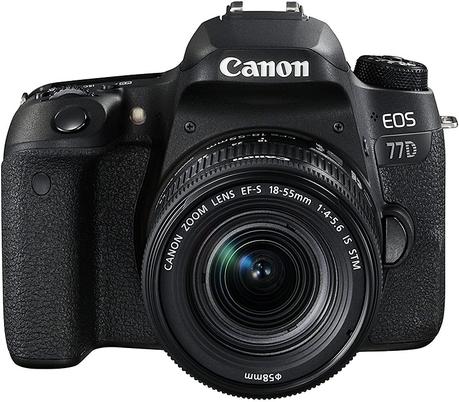
Check Price
The Canon EOS 77D is a recently launched APS-C sensor powered DSLR. It features a 24.2 megapixel APS-C CMOS sensor and Canon’s DIGIC 7 image processing engine. The EOS 77D is aimed at enthusiastic users who are looking to upgrade from a point & shoot camera as well as first time digital camera buyers who might be interested in something better than a Rebel. The EOS 77D pinches something from both the pro grade Canon systems as well as the Rebel series systems. Let’s find out more about these systems.
Sensor
The sensor inside the EOS 77D is a powerful 24.2 megapixel APS-C CMOS one. The sensor is capable of producing image files of the resolution 6000 x 4000 pixels. With a high resolution sensor on a smaller space, you can expect a bit of noise related issues, especially when shooting in low light and a bit of image softening as well especially at smaller apertures.
Image Processing
The EOS 77D is powered by Canon’s latest DIGIC 7 image processing engine.
Auto-focusing
Auto-focusing on the EOS 77D is powered by a 45-point all cross-type auto-focusing system.
ISO Sensitivity
The native ISO sensitivity of the camera is 100 – 25600. It can further extended to 51200.
Still Shooting
The EOS 77D is not cut out for fast action or sports or those sort of photography pursuits. But having said that the camera is no mug. It has a reasonable 6 fps continuous shooting speed and that should get you about a frame or two of sharp images if you shoot about 10-12.
Video Shooting
The EOS 77D shoots full HD (1920 x 1080p) at a frame rate of 60 (59.94) fps. The camera benefits from the dual pixel CMOS auto-focusing technology that powers the latest Rebels and many of the mid-range DSLRs. Dual-pixel CMOS auto-focusing uses on-sensor phase detection technology which can quickly lock focus even when shooting in live-view mode. This also benefits movie shooting. A built-in stereo microphone means you should be able to record decent quality sound in-camera as well.
Rear LCD Screen
The rear LCD screen of the camera is a large 3” 1.04 dot screen with touchscreen functionalities. The touchscreen functionality in Canon’s mid-sized cameras is a treat to work with, especially when shooting videos as well as live-view stills. It works pretty much the way your average smartphone’s tap to focus feature except much better.
Additionally, the LCD screen is a vari-angle one. It swivels which is why it becomes a lot easier to shoot from very acute angles. Movie modes are what would be perfect for this sort of screen. There are a million different things that you could do with this camera in terms of video shooting.
Connectivity
Built-in Wi-Fi is a must have these days, especially for the mid-range DSLRs. No one wants to plug their cameras to their laptops or run around with a SD card in hand. Simply switch to an available wireless network and start transferring images and videos.
The presence of NFC connectivity means pairing the camera with compatible devices is a lot easier than usual. In addition the EOS 77D also has Bluetooth connectivity. With Bluetooth you can use a tablet or smartphone device as a remote control for your camera.
Build Quality and Weather Sealing
The EOS 77D comes with a top LCD screen. A top LCD screen is very handy, especially when you need to quickly check what exposure settings you’ve got or what focus mode you have selected or the flash settings and make adjustments as required.
One thing for sure, the EOS 77D isn’t designed for outdoor photography in inclement weather. Weather sealing, as per Canon, isn’t something great. You wouldn’t want to take this out in the rain or for that matter in a dusty and extremely moist environment.
Read Customer Reviews on Amazon!
Best Flagship Full Frame DSLR Camera
-
Canon EOS-1D X Mark II
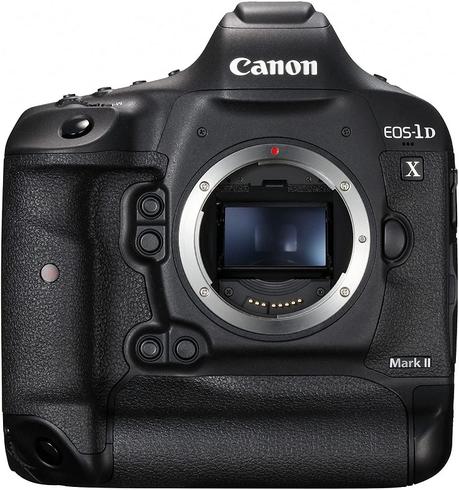
Check Price
The Canon EOS 77D is a recently launched APS-C sensor powered DSLR. It features a 24.2 megapixel APS-C CMOS sensor and Canon’s DIGIC 7 image processing engine. The EOS 77D is aimed at enthusiastic users who are looking to upgrade from a point & shoot camera as well as first time digital camera buyers who might be interested in something better than a Rebel. The EOS 77D pinches something from both the pro grade Canon systems as well as the Rebel series systems. Let’s find out more about these systems.
Sensor
The sensor inside the EOS 77D is a powerful 24.2 megapixel APS-C CMOS one. The sensor is capable of producing image files of the resolution 6000 x 4000 pixels. With a high resolution sensor on a smaller space, you can expect a bit of noise related issues, especially when shooting in low light and a bit of image softening as well especially at smaller apertures.
Image Processing
The EOS 77D is powered by Canon’s latest DIGIC 7 image processing engine.
Auto-focusing
Auto-focusing on the EOS 77D is powered by a 45-point all cross-type auto-focusing system.
ISO Sensitivity
The native ISO sensitivity of the camera is 100 – 25600. It can further extended to 51200.
Still Shooting
The EOS 77D is not cut out for fast action or sports or those sort of photography pursuits. But having said that the camera is no mug. It has a reasonable 6 fps continuous shooting speed and that should get you about a frame or two of sharp images if you shoot about 10-12.
Video Shooting
The EOS 77D shoots full HD (1920 x 1080p) at a frame rate of 60 (59.94) fps. The camera benefits from the dual pixel CMOS auto-focusing technology that powers the latest Rebels and many of the mid-range DSLRs. Dual-pixel CMOS auto-focusing uses on-sensor phase detection technology which can quickly lock focus even when shooting in live-view mode. This also benefits movie shooting. A built-in stereo microphone means you should be able to record decent quality sound in-camera as well.
Rear LCD Screen
The rear LCD screen of the camera is a large 3” 1.04 dot screen with touchscreen functionalities. The touchscreen functionality in Canon’s mid-sized cameras is a treat to work with, especially when shooting videos as well as live-view stills. It works pretty much the way your average smartphone’s tap to focus feature except much better.
Additionally, the LCD screen is a vari-angle one. It swivels which is why it becomes a lot easier to shoot from very acute angles. Movie modes are what would be perfect for this sort of screen. There are a million different things that you could do with this camera in terms of video shooting.
Connectivity
Built-in Wi-Fi is a must have these days, especially for the mid-range DSLRs. No one wants to plug their cameras to their laptops or run around with a SD card in hand. Simply switch to an available wireless network and start transferring images and videos.
The presence of NFC connectivity means pairing the camera with compatible devices is a lot easier than usual. In addition the EOS 77D also has Bluetooth connectivity. With Bluetooth you can use a tablet or smartphone device as a remote control for your camera.
Build Quality and Weather Sealing
The EOS 77D comes with a top LCD screen. A top LCD screen is very handy, especially when you need to quickly check what exposure settings you’ve got or what focus mode you have selected or the flash settings and make adjustments as required.
One thing for sure, the EOS 77D isn’t designed for outdoor photography in inclement weather. Weather sealing, as per Canon, isn’t something great. You wouldn’t want to take this out in the rain or for that matter in a dusty and extremely moist environment.
Read Customer Reviews on Amazon!
Best Update Flagship Models Camera
-
Canon EOS 7D Mark II
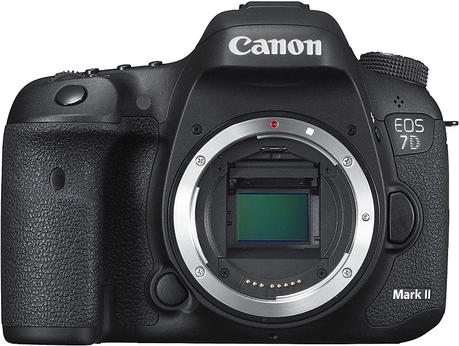
Check Price
The Canon EOS 7D Mark II builds on the reputation, performance and ergonomics that was set by its predecessor the EOS 7D.
Canon has always made it possible for APS-C photographers to really get the feeling of what it is like to wield a pro-level DSLR, without actually having to pay an insane amount of money.
In other words, Canon has always been serious about making available better and faster more performance oriented APS-C bodies with features that are frequently borrowed from their flagship bodies and sometimes improved.
Nikon has been far more circumspect in doing the same.
The result is amazing cameras such as the EOS 7D. The 7D, however, had become a dated design.
There was need for a better more powerful camera than the 7D. Thus, entered the much anticipated 7D Mark II. In many ways the 7D Mark II embodies the best of two worlds – a smaller form factor and with that combined the features of a pro body.
Even at the risk of sounding like an oxymoron, the EOS 7D Mark II is a camera that is aimed at not only APS-C enthusiasts but also serious pro level shooters who would love to take advantage of the crop factor with their long lenses.
Let’s dive deeper and find out how impressive the features of this camera really are.
Specifications
The Canon EOS 7D Mark II ups the resolution benchmark – 20.2 megapixel against 18 megapixel, but loses out on the individual size of the photodiodes 4.1 µm against 4.3 µm.
This is a vital piece of specification that often evades even the most seasoned eye. The smaller the individual size of the pixels, the less their ability to capture light. Smaller photodiodes also lead to noisier images.
Image Processing
The EOS 7D Mark II gets a dual DIGIC 6 image processor when compared to the EOS 7D.
The extra speed is noticeable as the 7D Mark II shoots full resolution stills at 10 fps and full HD videos at 60 fps, 30 fps and 24 fps with continuous auto-focusing. More on the continuous auto-focusing later in this review.
Auto-focusing: On-chip Phase Detection
The most notable feature of the EOS 7D Mark II is its dual-pixel CMOS auto-focusing system.
This is not the first time that we have seen this though. There are other cameras in the Canon line-up that already have this feature – the EOS 80D and before that the EOS 70D to name two.
This technique uses a revolutionary new sensor design.
80% of the pixels on the sensor are actually a composite of two individual photo-diodes. Each set sees an image coming in from one side of the lens only. These ‘twin’ images are then compared with each other and aligned to bring the final image into focus.
The technique is reminiscent of how rangefinder cameras work. In this case, however, the technology is marketed as on-chip phase detection system. This technology makes the older, slower contrast detection auto-focusing system redundant.
Advantages of the On-chip phase Detection System
The advantage of this system is that it is faster than traditional contrast detection systems that work only when the mirror flips away from in front of the sensor. Plus, being essentially chip based, the system is always on.
Another big advantage is that the system works in tandem with Canon’s STM lenses.
The greatest advantage is for those who shoot mostly in live-view or shoot videos. Continuous auto-focusing in video mode was a touchy subject in DSLR AF designing. Not many systems had accurate and reliable continuous auto-focusing in video mode before Canon came out with the dual-pixel CMOS AF system.
This camera boasts something which even the flagship EOS 1DX Mark II doesn’t have: a 65-point all cross-type AF system. The 61-point high-density reticular AF system that is on the EOS 1DX Mark II has only 41 cross-type AF points.
The center point of this high density cluster is a highly sensitive dual cross-type AF point that works with lenses f/2.8 or faster and can auto-focus even in -3EV.
This is ideal when shooting in extreme low light condition such as when shooting at indoor events or shooting wildlife at or after sundown.
Compatibility with STM lenses
STM stands for stepping motor. This is a smoother, much quieter AF motor and is an improvement over the older USM or ultra-sonic motors. This system produces a bit slower AF performance but the result, particularly when shooting videos is a lot smoother.
With USM lenses you would have suffered faster but jerkier AF which is an issue in film / video making. With STM lenses you don’t suffer the same problem.
Still Shooting
As already mentioned, continuous shooting speed is 10 fps at full resolution. Not many cameras except Sony’s DSLT (Digital Single Lens Translucent) cameras can shoot at 10 fps or higher.
Of course we are leaving out full-frame pro-level DSLRs in this discussion.
The EOS 7D Mark II is definitely ideal for shooting fast action, sports and wildlife photos, especially when birding. The crop factor of the APS-C sensor automatically makes the focal length of all full-frame lenses multiplied by a factor of 1.6x.
Even if you have a full-frame camera it would be fun to shoot with this camera for the ‘extended’ focal length.
Image sizes are 5472 x 3648 pixels. That means you can make large 18” x 12” industry standard 300 DPI prints without any loss in resolution. That too without having to upscale the image.
The camera supports 14-bit RAW.
ISO range
All cameras have what is known as a native and an extended ISO range.
The native ISO range is what the camera is able to shoot at without any software interference. Once that is transgressed the camera uses software to further increase the sensitivity of the sensor.
The native ISO range of the EOS 7D Mark II is 100-16000. On extended mode the ISO range extends to 51200.
You are definitely going to have a lot of noise when shooting at those ISO numbers.
Viewfinder & LCD Screen
The large and bright pentaprism powered viewfinder gives 100% frame coverage. This is imperative for making accurate compositions, especially for photographers who love to get it absolutely right in the camera.
The back of the camera is dominated by a large 3” LCD screen with a resolution of 1,040k-dots. This is a non-articulating screen.
This is basically where cameras like the EOS 80D win, because, with the 7D Mark II you are kind of limited with the camera angles you can shoot from. By the way, the screen gives 100% frame coverage.
Video Shooting
The video modes on the EOS 7D Mark II are more than enough for an enthusiastic videographer. The dual DIGIC 6 image processor ensures that the camera can handle high frame rates with élan.
It shoots full HD at 60, 30 and 24 fps. You have the option to shoot in either MOV or web-friendly MPEG-4 compression.
Plug, in an optional HDMI cable and you can capture the RAW unprocessed footage straight on an external recorder for further processing. Clips are fragmented after they reach a maximum file size of 4 GB.
The thing that you would be missing though, is built-in stereo sound recording. The EOS 7D Mark II only records linear PCM sound. You can however, plug in an external mic to record stereo quality sound. There’s also a headphone jack input that allows you to monitor the real time recording of sound.
Other Features
There are a bunch of other features on the EOS 7D Mark II. These include:
- Dual card slots for both CF and SD cards
- Built-in GPS
- Built-in intervalometer
- Compatibility with Canon’s eTTL flash system
- Built-in flash
- 150,000 pixel RGB metering + IR metering sensor.
- Magnesium alloy construction
- Significantly better weather sealing than the older 7D
- Hot-shoe to mount an external flash or other accessories
- USB 3.0 connectivity
- Better shutter cycle rating compared to its peers (200,000 against 150,000 on the Nikon D7200 and the older EOS 7D)
Conclusion
Overall, the EOS 7D Mark II is a serious piece of hardware. It integrates Canon’s latest dual-pixel CMOS auto-focusing technology with a 65 point all cross-type AF system that is borrowed from the flagship EOS 1DX Mark II and then improved.
It shoots stills at a phenomenal 10 fps, making it a dream for action, sports and wildlife photographers looking to use a long lens and take advantage of the crop factor.
Plus, the camera structure is a robust magnesium alloy construction and comes with, as Canon puts it, ‘4 times better weather sealing than the original 7D’ – something that outdoor photographer will feel a lot better when heading outdoors.
To conclude, the EOS 7D Mark II is a far superior camera than the one it replaces. It is definitely a great buy considering all aspects.
Read Customer Reviews on Amazon!
Best Affordable Full Frame DSLR Camera
-
Canon EOS 6D
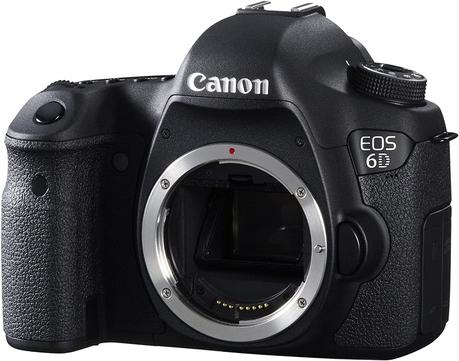
Check Price
Canon’s EOS 6D is a full-frame DSLR sporting a 20.2 megapixel CMOS sensor. In a clutter of APS-C sensor powered DSLRs the EOS 6D stands out with its full-frame sensor deceptively camouflaged as yet another small sensor camera. That is until you read the specs. The 6D does seem like an APS-C camera and that is probably the biggest USP of the camera, the small frame that houses a large sensor. Let’s find out more about it.
Sensor
As already explained, the sensor inside this DSLR is a 20.2 megapixel full-frame CMOS (35.8x 23.9mm) one capable of producing large fine JPEGs of the size 5472 x 3648 pixels. Larger sensors are better when it comes to gathering light. Low light imagery is one area where the large sensor will come in handy. You also get shallower depth of field for the same composition, compared to something like the 7D.
Image Processing
The 6D is powered by Canon’s DIGIC 5+ image processing engine.
Auto-focusing
The 6D is slightly better in terms of AF sensors when compared to smaller cameras. This is a dated model in anyways and that shows up on simple things such as the number of AF points. The EOS 6D has an 11 point AF system.
Comparatively, the entry level EOS Rebel SL1 has a 9 point AF system. The center AF point on the EOS 6D is a cross-type. The 6D, however nails AF in most lighting situations. With that you have the iFCL 63 zone dual layer metering sensor.
The thing that is missing is the sensor based (on-chip) phase detection technology. This would have been a mighty help for shooting in live-view as well as when shooting videos.
ISO Sensitivity
The native ISO capability of the sensor is 100 – 25600. It can be further extended to 50 – 102400.
Still Shooting
The continuous shooting speed of the EOS 6D is only 4.5 fps when shooting at full resolution.
Video Shooting
Canon’s DSLR cameras are good video shooters as well. The 6D is no different. It can shoot full HD videos at a frame rate of 30 fps. You have both All I-frame (IPB) and H.264 (MPEG 4) options for compression. A maximum of 29 mins and 59 seconds can be recorded in a single clip.
You have the option to record sound via an external mic. A feature of the camera is that you have full manual control over the exposure and the sound levels. That way you can control the exposure, the depth of field of your footages as well as the sound levels for a precise treatment.
Rear LCD Screen
Rear LCD screen of the EOS 6D is a decent 3” with a resolution of 1040,000 dots. The screen does not articulate, which is disappointing. Neither does it have touchscreen properties with the ability to touch and focus. This would have been perfect when shooting in live-view mode. The LCD screen, however, gives 100% coverage.
Connectivity
The 6D enjoys good connectivity parameters with a built-in wireless connectivity and GPS. Built-in wireless ensures the camera can transfer images and videos when a wireless connection is available. With GPS location data of the images can be embedded seamlessly and then later accessed via a map application.
Build Quality and Weather Sealing
The 6D is strikingly similar to the design and looks of the mid-range EOS 60D. The layout and button styling etc., are all taken from this very popular APS-C system. The 6D retains a few premium build quality features that are otherwise retained for pro-grade cameras. This includes a pentaprism instead of a pentamirror. Coverage of the viewfinder is however only 97%.
The camera has an aluminum alloy and polycarbonate chassis and then on top of it magnesium and polycarbonate has been used for the exterior. Overall weight of the system is 770 grams.
Read Customer Reviews on Amazon!
Best Perfect Shooter Beginners Camera
-
Canon EOS 1200D
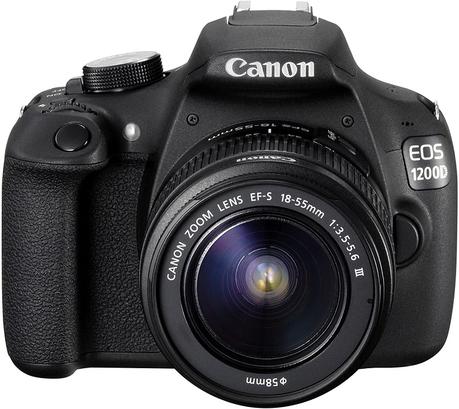
Check Price
The Canon EOS 1200D Digital SLR Camera is the perfect member of the prestigious Canon family for the beginner photographer.
This camera, released just one year ago, is available at a competitive price and is backed by the quality Canon brand of excellence.
As an added bonus, the Canon EOS 1200D comes complete with a Companion app – the perfect learner’s guide to using all of the features and functions of the camera.
Photo & Video Quality
The Canon EOS 1200D features major upgrades in comparison to its predecessor, the Canon 1100D, including an impressive 18mp sensor which increases resolution significantly from the 1100D’s 12.2mp.
Video capability is increased for the 1200D, allowing for 30, 25, or 24 fps footage at 1080p resolution. It can also produce video snapshots.
Storage
The 1200D does not come with built-in Wi-fi; however, it is compatible with Eye-fi memory cards, which allow wireless transfer of files to mobile devices.
Battery Performance
It should be mentioned that the 1200D’s battery is actually rated a bit below the performance of the battery of the 1100D, but it still produces an impressive 500 shots at temperatures as low as 23°C.
Software
The popular Canon Digital Photo Professional editing software package is bundled with the 1200D along with Photo Stitch, EOS Utilities, Browser EX, and Picture Style Editor. This impressive group of editing tools makes the Canon 1200D even bigger value.
Other Highlights
- The 18mp images delivered by the 1200D are large enough to create clear prints in sizes up to A2+.
- The screen has been resized from 2.7 inches to a full 3 inches.
- The autofocus sensor features nine points withthe center point cross-typed to increase sensitivity.
- The 8x magnification viewfinder matches the previous 1100D’s performance.
- In lieu of the latest DIGIC5 processor, the 1200D is fitted with the DIGIC4. This means that chromatic aberrations are not automatically corrected for JPGs. There are also an impressive number of creative filters which can be applied in the playback menu and adjusted to different levels of intensity.
- The 1200D is available complete with an 18-55mm f/3.5-5.6 IS III, the equivalent of 28.8-88mm in 35mm terms.
- It also features extensive image stabilization for clear, sharp shots.
Comfortable, Lightweight Design
Consumers have indicated being pleased with the improved design of the Canon 1200D’s body, citing more comfort and better handling due to the textured grip as opposed to the previously smooth one.
Many users are impressed with the lightweight design, especially those who use various lenses with this camera, indicating that the weight of the camera makes it possible to shoot for extended periods of time.
The Canon EOS 1200D: An Affordable, High Quality, Easy To Use Camera
Even those who admit to being “photographically challenged” are singing the praises of the Canon 1200D due to its ease of use and excellent picture and video quality.
A major point among consumers is also the great price of the Canon 1200D package.
Rather than having to spend time and money shopping and searching the web for various editing tools, the 1200D comes complete with a wide variety of specialty tools to choose from.
Experts and novices alike agree that this camera is an excellent product and offers exceptional value for money.
Read Customer Reviews on Amazon!

